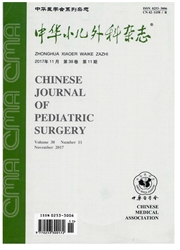

 中文摘要:
中文摘要:
目的研究c—Jun氨基末端激酶(c—JunN—terminalkinase,JNK)1/2在正常和尿道下裂患儿包皮组织中的表达,探讨其在尿道下裂发病机制的作用。方法收集尿道下裂尿道修复术和选择性包皮环切术中切除的包皮组织,分为轻中型尿道下裂组14例,重型尿道下裂组14例和正常对照组14例,采用实时定量聚合酶链反应(qPCR)和免疫组织化学方法检测JNKl/2mRNA和蛋白质磷酸化水平的表达,并比较其差异。结果轻中型和重型尿道下裂患儿包皮组织中JNKlmRNA表达分别为1.53±0.46和1.67±0.07,较正常对照的0.84±0.36差异有统计学意义(P〈0.05),尿道下裂组约为正常对照的1.9倍;但其在轻中型和重型尿道下裂之间的表达差异不显著。JNKl/2蛋白磷酸化水平在尿道下裂患儿包皮组织较正常表达呈升高趋势。结论JNK在尿道的发育以及尿道下裂发生中扮演一定角色。
 英文摘要:
英文摘要:
Objective To investigate the expression and phosporylation of c-Jun N -terminal ki- nase (JNK) 1/2 in the foreskin tissue collected from children with hypospadias. Methods Foreskin tissues collected during surgery from the children with hypospadias were divided into 2 groups accord- ing to the severity of the deformity: mild hypospadias group and severe hypospadias group. The fore- skin collected from the children underwent circumcision was taken as controls. Real-time quantitative polymerase chain reaction (qPCR) and immunoehemistry were employed to determine the mRNA ex- pression and phosporylation level of JNK1/2. Results The mRNA of JNK1 in the foreskin tissue of hypospadias patients increased to 1.9 folds of that of normal controls (P~0. 05). However, no sig- nificant difference of the mRNA of JNK1 was found between mild and severe hypospadias patients. The phosporylation level of JNK1/2 also significantly increased in hypospadias patients compared with that of controls. Conclusions The expression and phosporylation of JNK1/2 in the foreskin tissue col- lected from children with hypospadias are increased, which may be associated with the development of the hypospadias.
 同期刊论文项目
同期刊论文项目
 同项目期刊论文
同项目期刊论文
 期刊信息
期刊信息
